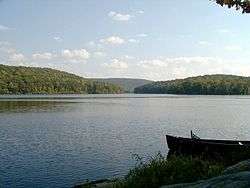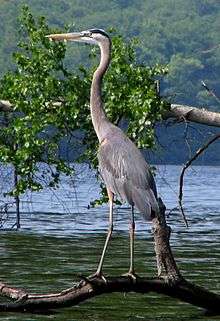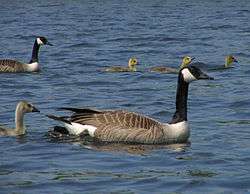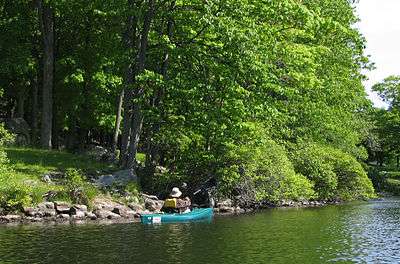Lake Sebago
At 310 acres (1.3 km2), Lake Sebago is the largest lake in Harriman State Park in the U.S. state of New York. The name is Algonquian for "big water". Operated by the Palisades Interstate Park Commission, Lake Sebago is surrounded by picnic lawns and play fields, and is popular with anglers fishing for bass, perch and sunfish. The lake has a former swimming beach, hand boat launch (electric motors only) and cabin camping. Lake Sebago lies near Sloatsburg. It is located just south of Lake Kanawauke and is accessible by auto from Seven Lakes Drive. New Sebago Beach, a beach that resided on the shore of the lake, opened in the 1940s but closed in 2011 due to being damaged by Hurricane Irene, and the picnic areas closed in 2014 due to Hurricane Sandy. New Sebago Beach has since been closed and abandoned, as well as the beach's parking lot and access road.
| Lake Sebago | |
|---|---|
 The lake in 2001 | |
| Location | Harriman State Park, Rockland County, New York, U.S. |
| Coordinates | 41°11′50″N 74°08′08″W |
| Etymology | Algonquian word for "big water" |
| Primary outflows | Stony Brook |
| First flooded | 1925 |
| Surface area | 310 acres (1.3 km2) |
History
The lake was created in 1925 by the Palisades Interstate Park Commission under William A. Welch by building a dam across Stony Brook. The lake filled the former site of Johnsontown—a pre-revolutionary logging settlement founded in the mid-1700s in the Stony Brook valley. By the early 1900s, Johnsontown was the largest mountain settlement in the western part of the Ramapos.
In 1916-17, the PIP condemned the land on the grounds that the settlement was built on swampland ("the great Emmetfield Swamp"). Many homeowners resettled in nearby Sloatsburg. The PIP took possession of the land and the homes, stores, school and church were torn down before the Stony Brook valley was flooded to create the new lake. Remnants of the Johnsontown sawmill is still visible to scuba divers.
The American Canoe Association and the New York chapter of the Adirondack Mountain Club have camps on the lake. The latter is named "Nawakwa", and dates to 1926, while the former, originally built for the Rogers Peet Company, was built in 1928 and was taken over by the ACA in 1933.
In 1927, a camp was built for the employees of four New York City banks. In 1986, the camp was turned over to a concessionaire to offer cabin camping to the public. Also in 1927, New York University opened a camp which they used until 1961; its facilities, too, are presently available to the public.
Photographs from Lake Sebago

 Canada goose with goslings
Canada goose with goslings

References
Sources
- Myles, William J., Harriman Trails, A Guide and History, The New York-New Jersey Trail Conference, New York, N.Y., 1999.
- Smeltzer-Stevenot, Marjorie, Old Burying Grounds, within Harriman and Bear Mountain State Parks, BookMasters, Inc., Ashland, Ohio, 1992.
External links
| Wikimedia Commons has media related to Lake Sebago, New York. |